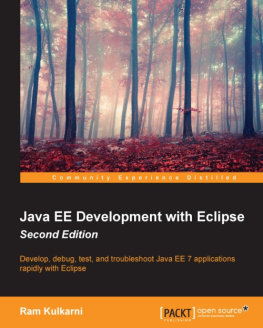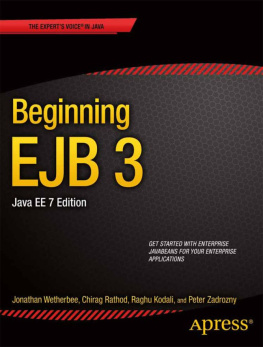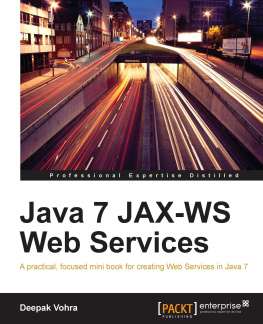This is a book for programmers interested in developing Java web services and Java clients against web services, whatever the implementation language. The book is a code-driven introduction to JAX-WS (Java API for XML-Web Services), the framework of choice for Java web services, whether SOAP-based or REST-style. My approach is to interpret JAX-WS broadly and, therefore, to include leading-edge developments such as the Jersey project for REST-style web services, officially known as JAX-RS (Java API for XML-RESTful Web Services).
Core Java only
This is the low-fuss approach that makes it easy to get web services and their clients up and running. The only required software is the Java software development kit (SDK), core Java 6 or later. Web services can be deployed easily using the Endpoint, HttpServer, and HttpsServer classes. The early examples take this approach.
Core Java with the current Metro release
This approach takes advantage of Metro features not yet available in the core Java bundle. In general, each Metro release makes it easier to write web services and clients. The current Metro release also indicates where JAX-WS is moving. The Metro release also can be used with core Java 5 if core Java 6 is not an option.
Standalone Tomcat
This approach builds on the familiarity among Java programmers with standalone web containers such as Apache Tomcat, which is the reference implementation. Web services can be deployed using a web container in essentially the same way as are servlets, JavaServer Pages (JSP) scripts, and JavaServer Faces (JSF) scripts. A standalone web container such as Tomcat is also a good way to introduce container- managed security for web services.
GlassFish
This approach allows deployed web services to interact naturally with other enterprise components such as Java Message Service topics and queues, a JNDI (Java Naming and Directory Interface) provider, a backend database system and the @Entity instances that mediate between an application and the database system, and an EJB (Enterprise Java Bean) container. The EJB container is important because a web service can be deployed as a stateless Session EJB, which brings advantages such as container-managed thread safety. GlassFish works seamlessly with Metro, including its advanced features, and with popular IDEs (Integrated Development Environment) such as NetBeans and Eclipse.
An appealing feature of JAX-WS is that the API can be separated cleanly from deployment options. One and the same web service can be deployed in different ways to suit different needs. Core Java alone is good for learning, development, and even lightweight deployment. A standalone web container such as Tomcat provides additional support. A Java application server such as GlassFish promotes easy integration of web services with other enterprise technologies.
Code-Driven Approach
My code examples are short enough to highlight key features of JAX-WS but also realistic enough to show off the production-level capabilities that come with the JAX-WS framework. Each code example is given in full, including all of the import statements. My approach is to begin with a relatively sparse example and then to add and modify features. The code samples vary in length from a few statements to several pages of source. The code is deliberately modular. Whenever there is a choice between conciseness and clarity in coding, I try to opt for clarity.
The examples come with instructions for compiling and deploying the web services and for testing the service against sample clients. This approach presents the choices that JAX-WS makes available to the programmer but also encourages a clear and thorough analysis of the JAX-WS libraries and utilities. My goal is to furnish code samples that can serve as templates for commercial applications.
JAX-WS is a rich API that is explored best in a mix of overview and examples. My aim is to explain key features about the architecture of web services but, above all, to illustrate each major feature with code examples that perform as advertised. Architecture without code is empty; code without architecture is blind. My approach is to integrate the two throughout the book.
Web services are a modern, lightweight approach to distributed software systems, that is, systems such as email or the World Wide Web that require different software components to execute on physically distinct devices. The devices can range from large servers through personal desktop machines to handhelds of various types. Distributed systems are complicated because they are made up of networked components. There is nothing more frustrating than a distributed systems example that does not work as claimed because the debugging is tedious. My approach is thus to provide full, working examples together with short but precise instructions for getting the sample application up and running. All of the source code for examples is available from the books companion site, at . Please let me know if you find any code errors.


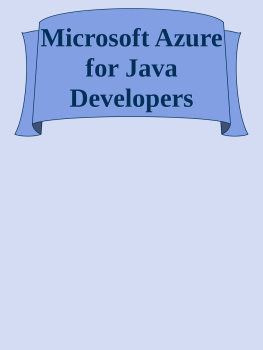
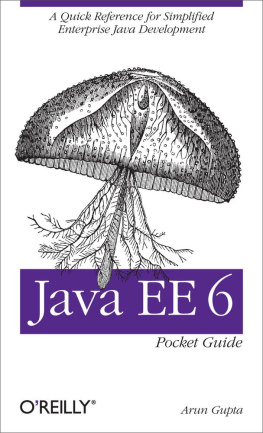
![Elder Moraes [Elder Moraes] - Java EE 8 Cookbook](/uploads/posts/book/119370/thumbs/elder-moraes-elder-moraes-java-ee-8-cookbook.jpg)
![Mario-Leander Reimer [Mario-Leander Reimer] - Building RESTful Web Services with Java EE 8](/uploads/posts/book/119360/thumbs/mario-leander-reimer-mario-leander-reimer.jpg)
